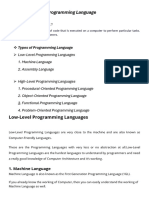0% found this document useful (0 votes)
11 views7 pagesVarious High and Low Level Programming Languages
The document provides a technical guide to high-level and low-level programming languages, explaining their definitions, characteristics, and uses. Low-level languages, such as machine and assembly language, are closer to hardware and offer fast execution but are difficult to read, while high-level languages like Python and Java are easier to understand and use, making them suitable for application development. The choice between the two types depends on the specific needs of the programming task, balancing efficiency and control against ease of development.
Uploaded by
himanshuthagele2710Copyright
© © All Rights Reserved
We take content rights seriously. If you suspect this is your content, claim it here.
Available Formats
Download as PPTX, PDF, TXT or read online on Scribd
0% found this document useful (0 votes)
11 views7 pagesVarious High and Low Level Programming Languages
The document provides a technical guide to high-level and low-level programming languages, explaining their definitions, characteristics, and uses. Low-level languages, such as machine and assembly language, are closer to hardware and offer fast execution but are difficult to read, while high-level languages like Python and Java are easier to understand and use, making them suitable for application development. The choice between the two types depends on the specific needs of the programming task, balancing efficiency and control against ease of development.
Uploaded by
himanshuthagele2710Copyright
© © All Rights Reserved
We take content rights seriously. If you suspect this is your content, claim it here.
Available Formats
Download as PPTX, PDF, TXT or read online on Scribd
/ 7























































































